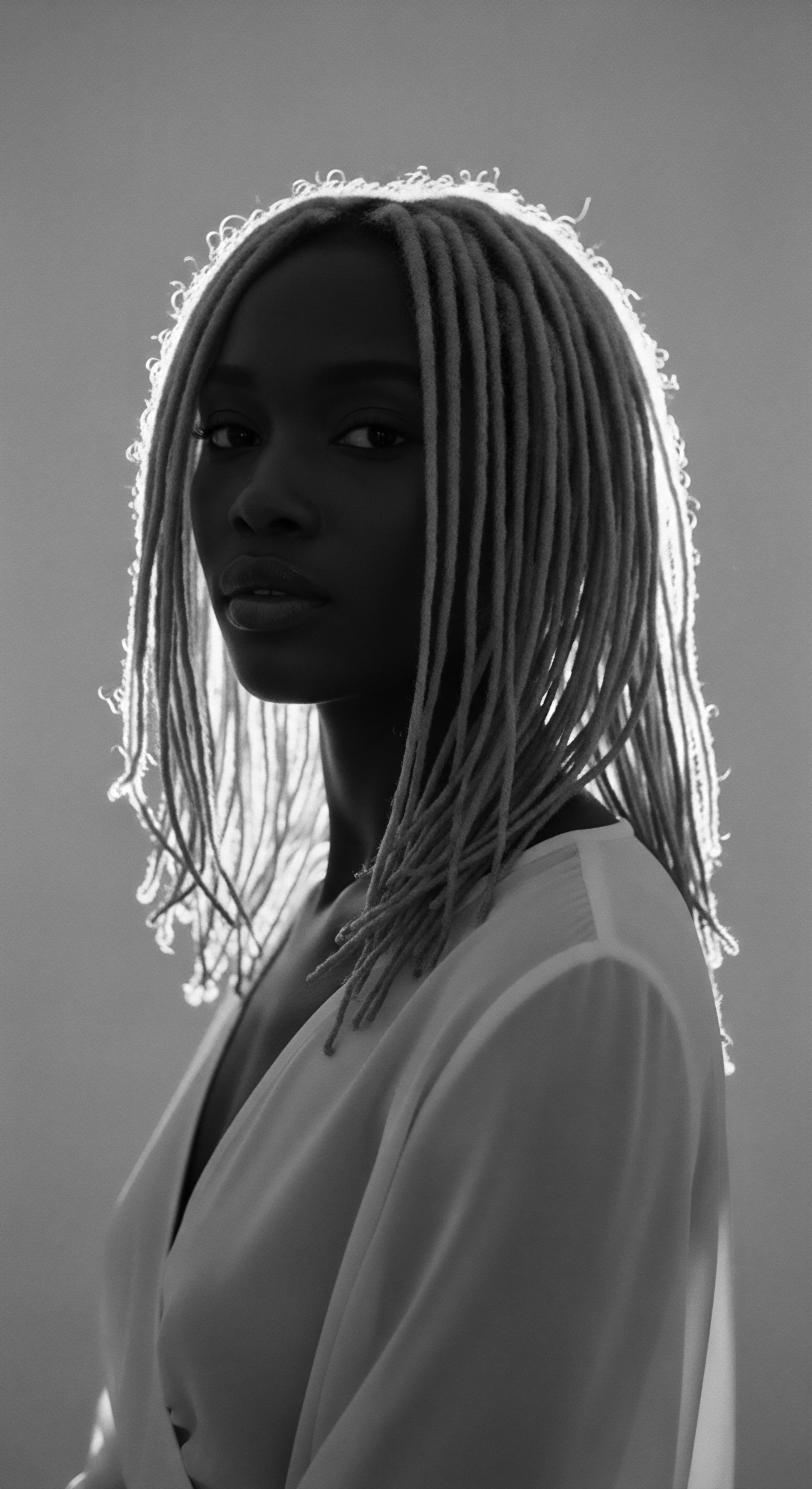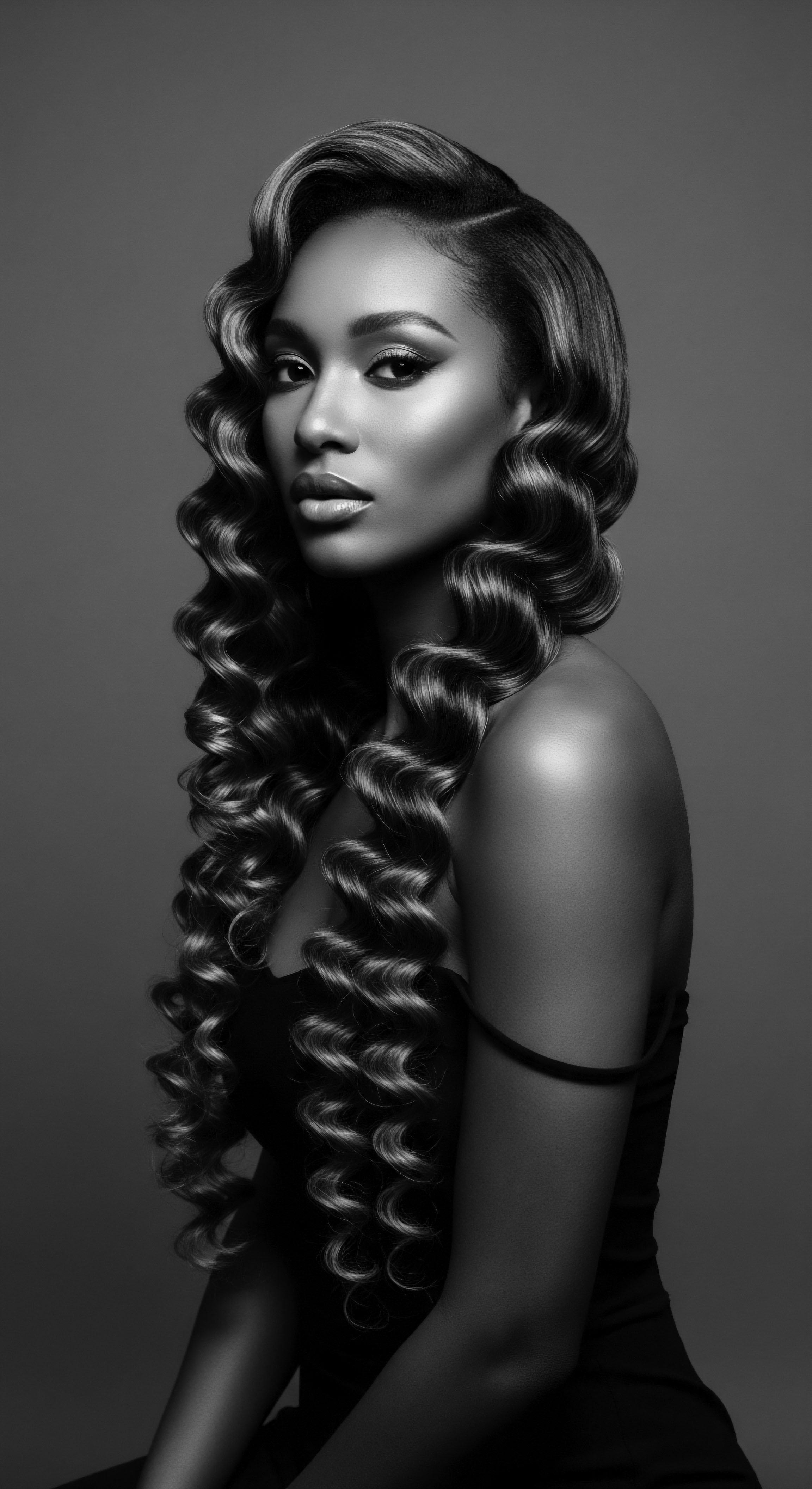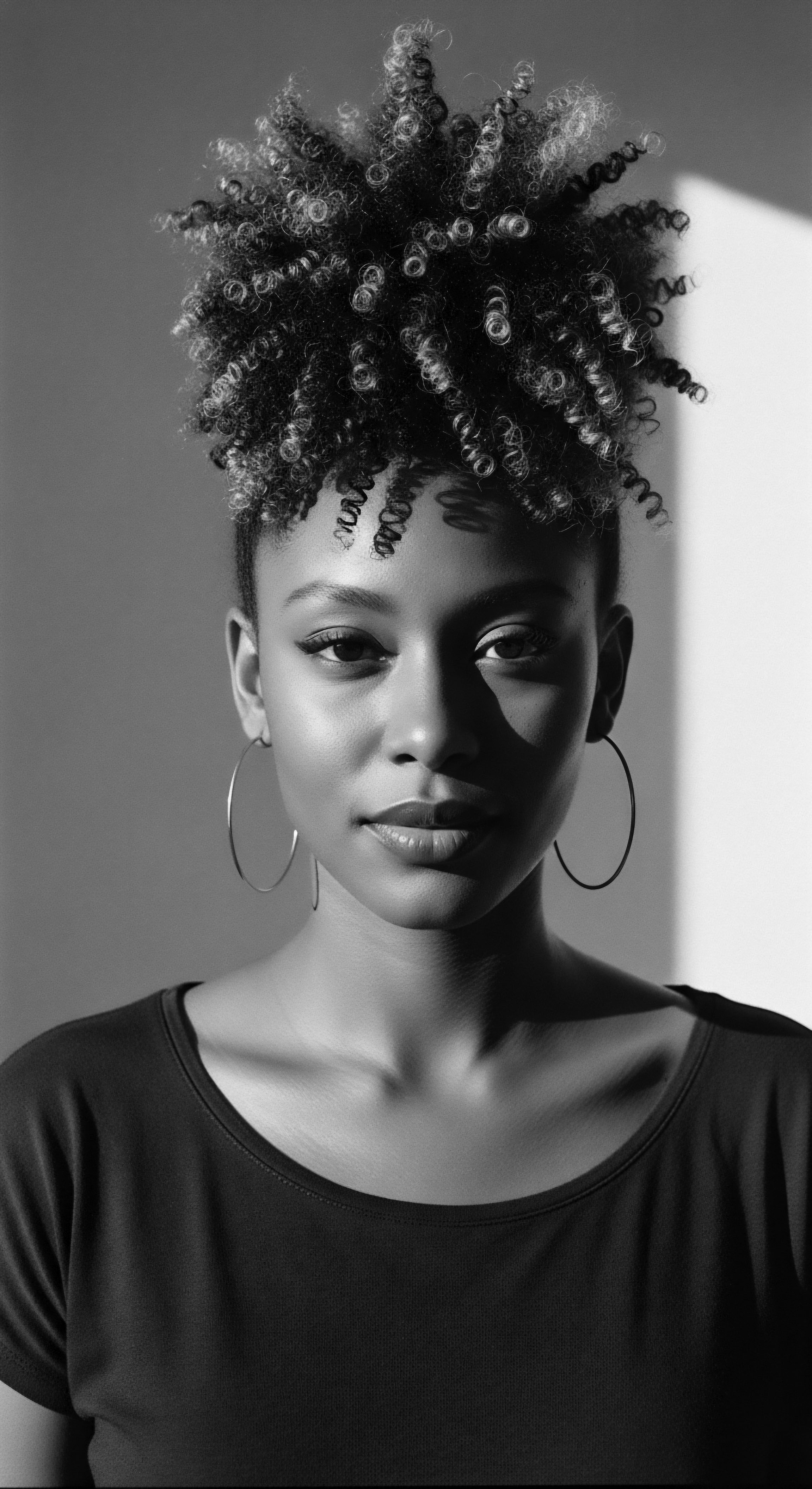
Fundamentals
The history of chemical hair straightening reveals a profound narrative, particularly for those with textured hair, whose ancestral practices have always honored the hair’s natural inclinations. At its core, chemical hair straightening describes processes that employ chemical agents to permanently alter the natural curl pattern of hair, transforming it from coiled or wavy states into a straightened form. This alteration fundamentally rearranges the hair’s protein structure, specifically targeting the disulfide bonds that give each strand its inherent shape. It represents a significant departure from traditional hair care, which often prioritized the maintenance and enhancement of hair’s natural state.
Before the advent of widespread chemical methods, people with textured hair often relied upon indigenous techniques, passed down through generations, to manage and style their hair. These methods celebrated the unique characteristics of each coil and curl, utilizing natural ingredients and tools. The very notion of permanently altering hair’s inherent structure through chemistry was not part of these ancient traditions. Understanding chemical hair straightening therefore necessitates looking back at the long legacy of hair care, which valued the intrinsic beauty of hair’s original texture.

Early Concepts of Hair Alteration
Across various civilizations, people have explored ways to modify their hair’s appearance. Early efforts to straighten hair were not inherently chemical, instead relying on mechanical or thermal means. Ancient Egyptian practices, for instance, sometimes involved alkaline substances to relax curls for a smoother appearance, signifying an early recognition of chemical reactions with hair.
However, these were rudimentary and lacked the precise, potent chemical formulations that would emerge centuries later. The primary focus of ancient hair care often revolved around cleanliness, adornment, and the symbolic meanings hair held within communities, rather than a radical change of its natural texture.
- Thermal Application ❉ Historically, heated tools like hot combs and irons represented some of the first widely accessible methods for straightening textured hair, particularly within Black communities. These tools offered a temporary modification, reshaping the hair through heat.
- Natural Elements ❉ Ancestral hair traditions across Africa and the diaspora frequently incorporated natural butters, herbs, and powders to moisturize, cleanse, and adorn hair. These ingredients supported hair health and manageability without fundamentally altering its structure.
The introduction of chemical straightening marked a pivotal shift, moving beyond temporary physical alterations to a more lasting molecular transformation. This change, while offering a new aesthetic, also presented complex implications for hair health and cultural identity, especially for those whose hair held deep communal and ancestral significance.
Chemical hair straightening fundamentally alters hair’s protein bonds, diverging from ancestral practices that honored and sustained natural textures.

Intermediate
Moving beyond the initial conceptualizations, the history of chemical hair straightening unfolds as a story intertwined with societal pressures and the evolving understanding of hair biology. This phase saw the emergence of dedicated chemical formulations, designed specifically to break and reform the hair’s structural bonds, creating a more permanent straight appearance than heat-based methods could offer. The motivations behind seeking such a transformation grew more complex, extending beyond mere aesthetics to encompass social acceptance and perceived opportunities.

The Dawn of Modern Formulations
The early 20th century witnessed significant developments in chemical hair straightening. Garrett Augustus Morgan, an African American inventor, is often credited with creating one of the first chemical hair relaxers in 1909. His initial discovery was accidental, observed while working on a solution to reduce friction for sewing machine needles.
He found the mixture had a surprising effect on fabric, leading him to test it on hair, ultimately formulating a straightening cream. This accidental discovery marked a significant moment, paving the way for products that promised a more lasting straightened style.
The chemical agents in these early relaxers were potent. Sodium hydroxide, commonly known as lye, became a primary active ingredient in many formulations. This strong alkali works by breaking the disulfide bonds within the hair shaft, allowing the hair to be re-shaped into a straight configuration.
The process demanded precision and care, as improper application could lead to severe scalp burns and hair damage. The desire for straight hair, however, often outweighed these risks, driven by burgeoning social currents.
| Method Hot Comb |
| Mechanism of Action Uses heat and pressure to temporarily flatten curls. |
| Connection to Heritage/Community A tool for managing hair, offering a straightened appearance for conformity, often used within family settings. |
| Method Lye-Based Chemical Relaxers |
| Mechanism of Action Sodium hydroxide breaks disulfide bonds permanently. |
| Connection to Heritage/Community Provided a more lasting straight style, often viewed as a pathway to social and economic assimilation. |
| Method These methods, while offering new possibilities for styling, also reflected and reinforced prevailing beauty standards that often devalued natural hair textures. |

Societal Currents and Hair Choices
The rise of chemical hair straightening within Black communities was deeply intertwined with socio-economic realities and prevailing beauty norms. In the early 20th century, particularly in the United States, straightened hair became associated with social and economic advancement. It was a tool of adaptation in a society that increasingly favored Eurocentric beauty standards. Many perceived straight hair as an asset that could elevate a woman’s personal, social, and economic standing, potentially providing more opportunities for success.
This was not simply a matter of personal style. The desire to conform to these standards was often a survival tactic, as opportunities for employment and social acceptance were often contingent upon adopting a “groomed” appearance that aligned with dominant norms. The practice of straightening hair became a widely adopted ritual, a means for Black women to navigate a world that frequently devalued their natural hair textures. It speaks volumes about the pressures placed upon individuals to adapt their ancestral appearance to fit into a narrowly defined societal mold.
The development of chemical hair straighteners marked a shift from temporary styling to a permanent alteration, driven by complex socio-economic pressures rooted in systemic bias.

Academic
The academic definition of Chemical Hair Straightening History is a multifaceted exploration, one that transcends mere chronological events to delve into the intricate interplay of molecular chemistry, deeply entrenched cultural narratives, and the lived experiences of individuals, particularly those within Black and mixed-race communities. It represents a profound shift in human interaction with hair, moving from ancient practices of adornment and natural care to the deliberate, permanent alteration of genetic hair structure through synthetic compounds. This history is not simply a record of product development; it is a vital lens through which we can understand evolving concepts of beauty, racial identity, and socio-economic survival across the diaspora.
From a scientific perspective, chemical hair straightening, or hair relaxing as it is colloquially known, involves a controlled chemical reaction that disrupts the hair’s primary structural integrity. Hair’s natural shape is largely determined by its unique keratin protein arrangement and the disulfide bonds that link cysteine residues within these proteins. These bonds are responsible for the strength and curl of the hair fiber.
Chemical straighteners primarily target these bonds, altering their configuration to produce a straightened effect. The meaning of this process extends into the very biology of hair, transforming its fundamental architecture.

Chemical Mechanisms and Hair Biology
The core of chemical hair straightening lies in lanthionization, a process predominantly facilitated by strong alkaline agents such as sodium hydroxide (lye) or guanidine hydroxide (in many “no-lye” formulations). When applied to hair, these high-pH compounds swell the hair shaft and penetrate the cuticle, reaching the cortex. They then break the disulfide bonds, converting them into lanthionine bonds, which are irreversible. This permanent chemical change allows the hair to be mechanically straightened, and once rinsed and neutralized, the hair retains its new, straightened configuration.
- Sodium Hydroxide (Lye Relaxers) ❉ Known for their efficacy, these relaxers work by breaking a significant number of disulfide bonds. They produce a very straight result but carry a higher risk of scalp irritation and chemical burns due to their extreme alkalinity.
- Guanidine Hydroxide (No-Lye Relaxers) ❉ While often perceived as milder, these systems still employ strong alkaline compounds. They are typically mixed just before application, creating guanidine hydroxide from calcium hydroxide and guanidine carbonate. They can cause less scalp irritation than lye relaxers but may lead to greater hair dryness and brittleness over time due to calcium buildup.
- Ammonium Thioglycolate (Thio Relaxers) ❉ These formulations, common in perms that create curls, are used at higher concentrations and pH for straightening. They break disulfide bonds but reform them through an oxidation process, offering a different chemical pathway to alteration.
The scientific understanding of these mechanisms is crucial, as it underpins the potential for both desired aesthetic outcomes and unintended health consequences. The inherent nature of textured hair, characterized by its elliptical cross-section and varying curl patterns, makes it particularly susceptible to damage from these powerful chemical interventions.

Socio-Historical Context and Cultural Imperatives
The historical trajectory of chemical hair straightening is inextricably linked to the socio-political landscapes experienced by Black people, particularly in the Western world. Following the abolition of slavery, Black Americans continued to seek avenues for social and economic integration. In a society that perpetuated Eurocentric beauty ideals, straight hair became a symbol of respectability, professionalism, and assimilation. This deeply rooted societal bias often positioned natural Afro-textured hair as “unruly,” “unprofessional,” or “messy,” creating immense pressure to conform.
For many, altering hair texture was not an act of self-hatred, but rather a pragmatic choice for survival and advancement in a discriminatory environment. The “Good Hair” discourse, where “good hair” was defined by its proximity to European hair textures, emerged as a societal construct, influencing self-perception from an early age. (Bencosme, 2017) This societal pressure was profound, extending into professional and educational spheres. For example, a 2019 study by the Perception Institute found that One in Five Black Women Felt Social Pressure to Straighten Their Hair for Work, and One in Four Black Adults Experienced Negative Hair-Related Experiences at School. This compelling data illuminates how systemic biases translated into personal decisions about hair, deeply impacting self-worth and belonging.
The history of chemical hair straightening is a complex interplay of molecular science and profound social forces, particularly for Black communities.
The commercialization of chemical straighteners in the early 20th century by figures like Garrett Augustus Morgan, and later by companies that followed his lead, directly addressed this societal demand. While innovators like Madam C.J. Walker primarily focused on scalp health and hair growth, using hot combs for styling rather than chemical alteration, the broader market quickly recognized the powerful desire for chemical straightening. The industry rapidly expanded, heavily marketing products with terms such as “straight,” “smooth,” and “silky,” thereby perpetuating a negative perception of natural hair.

Interconnected Incidences and Long-Term Consequences
The widespread and prolonged use of chemical hair straighteners has generated a complex array of interconnected incidences, reaching from individual health to broader societal well-being. The chemical components, particularly parabens, phthalates, and formaldehyde-releasing agents, have raised significant health concerns. These compounds are identified as endocrine-disrupting chemicals (EDCs), capable of interfering with the body’s delicate hormonal balance.
Recent academic studies have begun to draw alarming connections between these chemicals and various health issues disproportionately affecting Black women. Research has indicated a potential link between the use of chemical straighteners and an increased risk of uterine fibroids, early puberty, and certain hormone-related cancers, including breast, ovarian, and uterine cancers. For instance, the Sister Study, a multi-decade research project by the National Institute of Environmental Health Sciences, found “evidence of association between the use of straightening chemical products and uterine cancer,” noting that participants who frequently used straighteners were predominantly African American or Black women. This finding underscores the profound health disparities linked to beauty practices historically influenced by racialized beauty norms.
Furthermore, the physical damage to the hair and scalp from chronic use of these products is well-documented, including hair breakage, thinning, and various forms of alopecia. Beyond the physical, the psychological and cultural consequences are equally significant. The historical pressure to straighten hair for acceptance often leads to internalized racism and negative self-image, contributing to anxiety and hypervigilance about how one’s hair is perceived in academic or professional settings. This can create a deep sense of cultural disconnection and isolation, impacting mental well-being over a lifetime.
The narrative of chemical hair straightening, therefore, is not a simple linear progression of innovation. It is a deeply layered account reflecting historical oppression, the intricate chemistry of hair, the adaptive resilience of a community, and the ongoing struggle to reclaim ancestral beauty standards. The dialogue surrounding hair discrimination, such as the CROWN Act, reflects a contemporary effort to dismantle these ingrained biases and validate the inherent beauty of all hair textures.
The definition of chemical hair straightening history, thus, must hold space for both the scientific mechanisms that allow for hair transformation and the profound cultural meanings and health implications that accompany such a journey. It is a testament to the enduring power of hair as a symbol of identity, adaptation, and liberation.

Reflection on the Heritage of Chemical Hair Straightening History
The journey through the history of chemical hair straightening, particularly as it relates to textured hair, reveals more than just a progression of scientific advancements; it offers a profound meditation on heritage, resilience, and the evolving spirit of self-definition. From the rhythmic whispers of ancestral care practices that nurtured hair in its natural glory to the powerful, sometimes painful, embrace of chemical alteration, each strand tells a story. This story is deeply etched with the echoes of societal expectations, the weight of imposed beauty standards, and the unwavering strength of communities navigating a world often unreceptive to their authentic selves.
In every coil and wave, the memory of ancient traditions lives on, a testament to hair as a living archive of identity and communal connection. The wisdom passed down through generations—the careful blend of natural emollients, the communal braiding sessions, the understanding of hair as a crown—forms the tender thread that binds past to present. Even as chemical straighteners became a pervasive reality, a means of survival in a biased society, the ancestral spirit of care remained, subtly influencing how these powerful agents were applied and understood within the home.
Today, as we witness a vibrant return to natural hair, a profound re-embracing of ancestral textures, the history of chemical straightening serves as a powerful reminder. It illuminates the sacrifices made for belonging, the psychological tolls endured, and the unwavering spirit that persists. The unbound helix, once chemically constrained, now spirals freely, expressing a renewed confidence and a deep reverence for the inherited beauty of textured hair. This heritage, rich with complexity and layered meanings, invites us to honor every step of the journey, acknowledging both the adaptations made for survival and the enduring quest for genuine self-acceptance and wellness.

References
- Bencosme, Y. (2017). Beauty is Pain ❉ Black Women’s Identity and Their Struggle with Embracing Natural Hair. University of New Hampshire Scholars Repository.
- Byrd, A. D. & Tharps, L. D. (2014). Hair Story ❉ Untangling the Roots of Black Hair in America. St. Martin’s Press.
- Feagin, J. R. (2014). Racist America ❉ Roots, Current Realities, and Future Reparations. Routledge.
- Hunter, P. (2013). Buying Beauty ❉ The Ethnic Beauty Industry in the United States. Lexington Books.
- Malone, A. T. (1928). Poro Beauty Culture ❉ The New Art of Hair and Skin Care. Poro College.
- Morgan, G. A. (1913). G.A. Morgan’s Hair Refiner ❉ A Scientific Preparation for Straightening Hair. G.A. Morgan Hair Refining Company.
- Perception Institute. (2019). The Good Hair Study ❉ Explicit and Implicit Attitudes Toward Black Women’s Hair.
- Randle, S. (2015). Black Hair ❉ Art, Culture, and History. Routledge.
- Robinson, J. S. (2011). The New Civil Rights Movement ❉ For Love of Hair. CreateSpace Independent Publishing Platform.
- Thompson, C. (2009). Black Women and Beauty Culture in 20th-Century America. Oxford Research Encyclopedia of American History.
- Walker, M. C. J. (1917). Text Book of the Madam C. J. Walker Schools of Beauty Culture. Madam C.J. Walker Manufacturing Company.
- White, M. (2005). The Science of Black Hair ❉ A Comprehensive Guide to Textured Hair. Milady.
